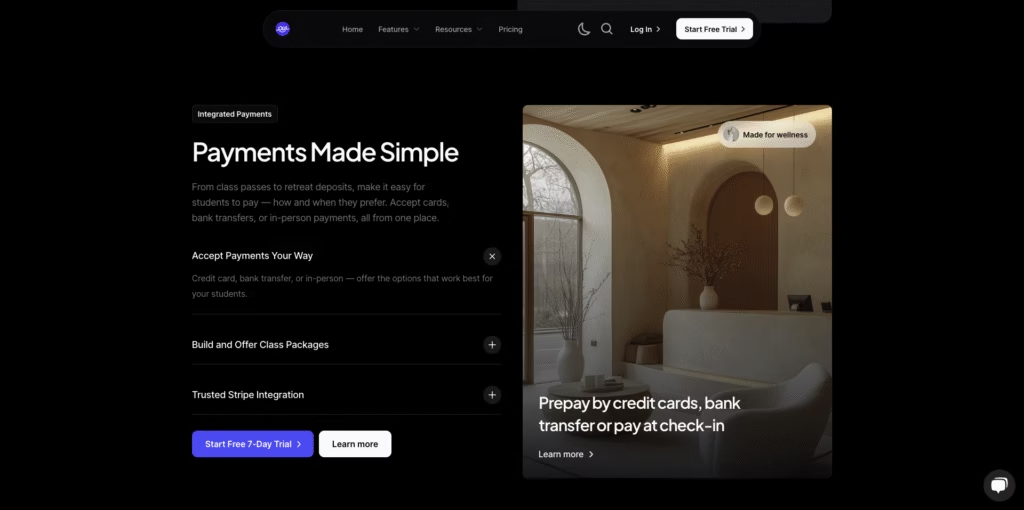When it comes to turning your yoga passion into a profitable career, many yoga teachers find themselves wondering, How do I maximize earnings as a yoga teacher? Whether you’re just starting out or looking to increase your income, understanding your value and developing a variety of income streams can lead to greater financial success. In this article, we will break down the different ways to increase your earnings, from yoga teacher jobs with hourly rates to higher-level strategies for pricing workshops, private lessons, and retreats.
1. Understanding Yoga Teacher Salaries: What’s the Going Rate?
Before you dive into maximizing your earnings, it’s important to understand what you can typically earn as a yoga teacher. While the salary varies based on experience, location, and other factors, here’s a closer look at what you might expect:
Studio Classes
Yoga teachers at studios typically earn $25–$50 per class, depending on where they teach. Teachers in cities with higher living costs (such as New York, Los Angeles, or London) can make $60–$100 per session.
However, this can fluctuate based on the studio’s clientele, popularity, and the size of the class. New teachers might find themselves starting on the lower end, but as you gain experience and build a following, you’ll be able to negotiate a higher pay rate.
Private Yoga Sessions
Private lessons are one of the most lucrative ways to make money as a yoga teacher. Rates for private sessions generally range from $75–$200 per hour, and more experienced instructors can ask for even more.
These sessions allow you to offer highly personalized guidance, which justifies a premium rate. Many private clients are willing to pay a higher rate for individual attention, especially if they are working on specific physical or mental goals.
Online Yoga Classes
With the rise of digital platforms, online yoga classes have become a viable revenue stream for teachers. If you’re teaching virtually, you might charge anywhere from $10–$50 per session for a live-streamed class or video-on-demand format.
Creating your own yoga content to sell or offer through subscription services (like a monthly membership) can significantly increase your reach and income.
Specialized Yoga Classes or Private Packages
Offering classes designed for specific niches (like prenatal yoga, therapeutic yoga, or yoga for athletes) can allow you to charge higher rates because these classes cater to a specialized audience.
For example, a therapeutic session for injury recovery could range from $100–$150 per hour, given the added value of personalized and targeted attention.
🧘 Need help structuring your classes or workshops? Download our free Yoga Deck, a printable sequence builder designed just for teachers.
2. Optimizing Hourly Rates for Yoga Teacher Jobs

As you work your way through different yoga teacher jobs, there are several ways you can optimize your hourly rate, making sure you are compensated fairly for your time, expertise, and effort. Here’s how to adjust your hourly rates to maximize your earnings:
Gain Experience and Specialize
As you continue to teach, you’ll build more experience, which justifies a rate increase. Adding advanced certifications and specialized training (such as yoga therapy or trauma-informed yoga) allows you to command higher rates. Specialized teachers can charge a premium for their niche expertise because they provide a unique service that can’t easily be replicated.
Increase Class Size and Value
A yoga teacher’s hourly rate is often tied to the number of students in the class. The larger the class, the more income you can generate. If you’re teaching in a studio, aim to build a loyal following. By consistently filling your classes, you can negotiate with the studio owner for higher pay or take on additional classes.
In the case of private sessions, offering packages for multiple lessons (such as a 5- or 10-class package) can encourage clients to commit while ensuring steady income.
Offer Hybrid Formats or Multiple Class Types
If you primarily teach group classes, you might consider offering a hybrid format that blends group instruction with personal adjustments, which can justify a higher price per student.
You can also diversify your teaching methods, offering specialized sessions (like a “Yoga and Meditation” combo class) or an extended session (such as 90-minute classes instead of the standard 60-minute format) for higher pay.
Consider Your Client’s Willingness to Pay
Assess the income level and demographic of your audience when setting your rates. If you are teaching in an affluent area or working with corporate clients, you may be able to charge premium rates.
Similarly, if you are teaching at a lower-cost studio or working with a community-based group, you might offer more affordable pricing to stay competitive.
3. Pricing Strategy for Workshops and Events
Workshops and events are an excellent way to significantly increase your income as a yoga teacher. Not only do they allow you to connect with your students in a deeper way, but they also present an opportunity to earn a higher income per event. Here’s how you can strategically price your workshops and events for maximum earnings:
- Understand Market Demand:
Before setting prices, understand your audience. What are their interests? Are they looking for advanced practices, meditation, or specific yoga techniques? Knowing the needs of your community allows you to create workshops that students will want to pay for. For example, a workshop on “Healing Through Yoga” or “Advanced Arm Balances” might attract more students and allow you to price it higher. - Location and Accessibility Matter:
Pricing varies depending on the location of your workshop. If your event is in a larger city or a destination retreat, you can typically charge more due to the added appeal and accessibility of the event. Consider offering tiered pricing for different levels of access (early-bird, general admission, VIP, etc.) to maximize your revenue. - Consider Length and Content Depth:
The more intensive the workshop, the more you can charge. For example, a one-day workshop might range from $50–$200, but a weekend retreat could easily earn you $500–$2,000 or more, depending on how many students attend. Workshops with specialized content or certification courses can also bring in additional revenue. - Use Discounts and Incentives:
Offering early bird rates or discounts for groups (e.g., “bring a friend” deals) can help fill your events. While it’s important to avoid devaluing your work, these strategies can incentivize students to commit to a session earlier, securing spots in your event and guaranteeing steady revenue.

💡 Want to streamline your workshop signups and take payments automatically? Get started for free with TheFlowOps.
4. Offering Retreats for Significant Earnings
Hosting yoga retreats is one of the most lucrative ways for yoga teachers to earn. Not only do they allow you to work with students in a more immersive setting, but retreats also generate higher profit margins compared to regular classes. Here’s how to price your retreats for maximum earnings:
Offer Tiered Pricing for Different Levels
A retreat with an all-inclusive price (including lodging, meals, and activities) can be priced according to the level of accommodation. For example, more luxurious accommodations could be offered at a premium price, while basic lodging options can be more affordable.
This flexibility allows you to cater to a broader range of clients while still maximizing revenue from those who are willing to pay more for a premium experience.
Plan for Retreats with Clear Value Propositions
Position your retreat as an experience beyond yoga practice. Include additional elements like hiking, cooking classes, massage therapy, or nature walks to increase its appeal. Students will pay more if they perceive the value of the retreat as transformational, rather than just a regular yoga getaway.
Market Early to Build Momentum
Start marketing your retreat well in advance to ensure you get enough sign-ups. Offering early bird discounts or exclusive perks for the first 5-10 sign-ups can create a sense of urgency while providing testimonials from past retreat attendees can boost your credibility.
5. Expanding Your Revenue Stream: Digital Content, Merchandise, and More
Beyond teaching classes and leading workshops, there are several ways to generate additional revenue as a yoga teacher:
- Create a Digital Yoga Library:
Offering video-on-demand sessions, downloadable yoga sequences, or subscription-based memberships is a great way to earn passive income. By leveraging your existing content and repurposing it for online formats, you can generate recurring income without constantly needing to teach. - Sell Yoga-Related Merchandise:
Selling your own branded yoga accessories, like mats, blocks, or apparel, can add another stream of income. Consider selling unique items that align with your personal brand or the values of your students. - Affiliate Marketing for Yoga Products:
Many yoga instructors become affiliates for eco-friendly yoga brands or wellness products. By recommending these products to your followers and students, you can earn commissions for each sale made through your affiliate link. - Offer Online Courses:
If you have a particular area of expertise—like meditation, mindfulness, or advanced postures—you can create and sell online courses. These courses can be pre-recorded or offered live, and they provide an opportunity to earn money from students worldwide.
Ready to package your content and sell yoga sequences online? Create your yoga teacher website and start earning passively.
6. Use Pre-Made Templates to Launch Faster
Not sure where to start with building your site, creating your schedule, or setting up your class offerings? TheFlowOps offers a growing library of free templates to help yoga teachers launch quickly and professionally.

You’ll find templates for:
- Class booking pages
- Instructor bios
- Online course sales pages
- Retreat registration
- Full yoga websites
These pre-built templates are customizable and plug directly into your TheFlowOps dashboard, saving you hours of setup time while helping you look polished and credible from day one.
How TheFlowOps Can Help
Running a thriving yoga business means juggling classes, clients, bookings, payments, and content—all while staying connected to your community. TheFlowOps was built specifically to support yoga teachers like you.
- Website Builder – Build a beautiful, mobile-optimized yoga teacher website in minutes with no coding. Easily showcase your offerings, link to your schedule, and embed payment buttons directly on your site.
- Online Scheduling – Let students book sessions, workshops, or private classes directly from your calendar using TheFlowOps Scheduler. Set availability, avoid double-booking, and even automate reminders.
- Payment Tools – Accept payments online or in person using TheFlowOps Payments. Create custom packages, subscription plans, and one-click checkouts for workshops, classes, and retreats.
Whether you teach in person or online, TheFlowOps helps you reduce administrative load and focus more on teaching.
Final Thoughts: Your Path to a Profitable Yoga Career
Maximizing your earnings as a yoga teacher involves more than just teaching classes—it’s about creating a business model that incorporates multiple revenue streams, including private sessions, workshops, retreats, and digital content. By understanding how to price your offerings strategically and leveraging platforms like TheFlowOps, you can elevate your yoga career to new heights. With the right approach and tools in place, you’ll find that not only can you do what you love, but you can do it in a financially sustainable way that supports both you and your students for years to come.
Whether you’re managing a full retreat or building your first email list, the right systems will free you up to focus on teaching. Try TheFlowOps free or download the Yoga Deck to begin planning your next class.



